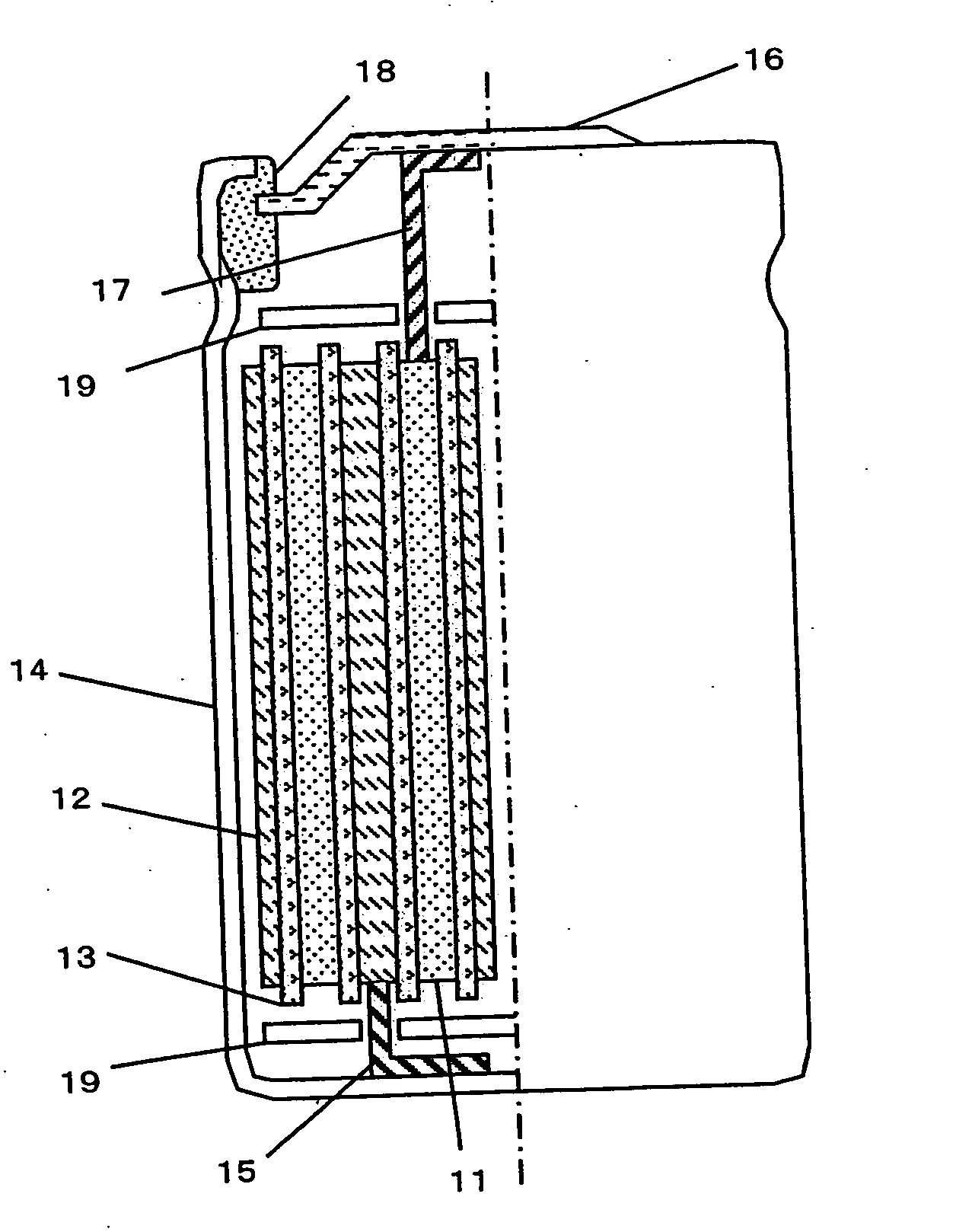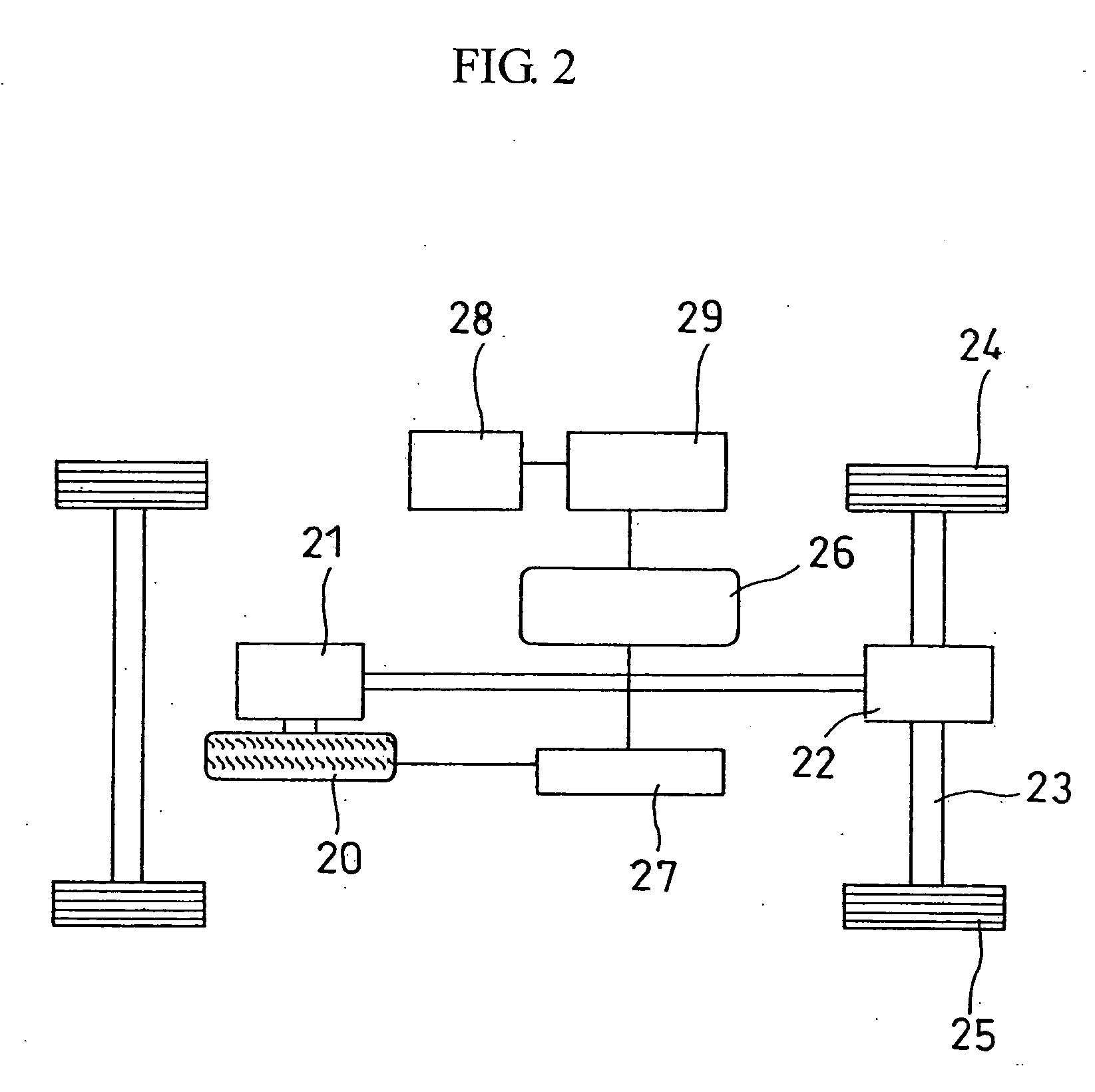Lithium ion secondary battery
a secondary battery and lithium ion technology, applied in the field of can solve the problems of significant voltage drop, high output power, and difficulty in realizing lithium ion secondary batteries having high output characteristics, and achieve high output characteristics, high output power, and high output characteristics.
- Summary
- Abstract
- Description
- Claims
- Application Information
AI Technical Summary
Benefits of technology
Problems solved by technology
Method used
Image
Examples
example 1
[0045] 18650 cylindrical lithium ion secondary batteries (Battery 1), (Battery 2) and (Battery 3) were manufactured as Example 1 of the present invention as follows.
[0046] A positive electrode was first manufactured. A composite oxide powder represented by LiNi0.34Mn0.33Co0.33O2 was used as the positive-electrode active material. 9 wt % of flaky graphite as a conducting agent, 1.7 wt % of acetylene black and a solution containing 4.3 wt % of PVDF dissolved in NMP as a binder were added to 85 wt % of this positive-electrode active material and mixed together to prepare a positive-electrode mix slurry. This slurry was substantially uniformly and equally applied to 20 μm-thick aluminum foil (positive-electrode current collector) and dried at 80° C. and further to both sides of the aluminum foil and dried likewise. The coating weight on the positive electrode was adjusted to ensure that the weight of the dried mix became 8.0 mg / cm2. Thereafter, the obtained laminate was compression mol...
example 2
[0056] 18650 cylindrical lithium ion secondary batteries (Battery 4), (Battery 5) and (Battery 6) were manufactured as Example 2 of the present invention as follow.
[0057] As the negative-electrode active materials, a graphite-based material D having an average particle diameter of 22 μm, a graphite-based material E having an average particle diameter of 1.9 μm and a graphite-based material F having an average particle diameter of 9.0 μm were used in (Battery 4), (Battery 5) and (Battery 6), respectively. The graphite-based material D had an H value of 1.63, a C value of 1.20, an R value of 0.54 and a Δ value of 105 cm−1 The graphite-based material E had an H value of 1.23, a C value of 1.11, an R value of 0.45 and a Δ value of 70 cm−1. The graphite-based material F had an H value of 1.22, a C value of 0.82, an R value of 0.37 and a Δ value of 36 cm−1. Lithium ion secondary batteries were manufactured in the same manner as in Example 1 except for the above.
[0058] Table 1 shows the ...
example 3
[0059] 18650 cylindrical lithium ion secondary batteries (Battery 7), (Battery 8), (Battery 9) and (Battery 10) were manufactured as Example 3 of the present invention as follows.
[0060] The graphite-based material A was used as the negative-electrode active material, the amount of the conducting agent contained in the negative-electrode depolarizing mix and the coating weight of the depolarizing mix were changed and thereby, the coating weight of the positive electrode was changed. In (Battery 7), the amount of the conducting agent was 0.6 wt %, the coating weight of the negative electrode was 1.4 mg / cm2, and the coating weight of the positive electrode was 5 mg / cm2. In (Battery 8), the amount of the conducting agent was 1.2 wt %, the coating weight of the negative electrode was 2.0 mg / cm2, and the coating weight of the positive electrode was 6 mg / cm2. In (Battery 9), the amount of the conducting agent was 9.5 wt %, the coating weight of the negative electrode coating was 5.0 mg / cm...
PUM
| Property | Measurement | Unit |
|---|---|---|
| particle diameter | aaaaa | aaaaa |
| temperature | aaaaa | aaaaa |
| 2θ | aaaaa | aaaaa |
Abstract
Description
Claims
Application Information
 Login to View More
Login to View More - R&D
- Intellectual Property
- Life Sciences
- Materials
- Tech Scout
- Unparalleled Data Quality
- Higher Quality Content
- 60% Fewer Hallucinations
Browse by: Latest US Patents, China's latest patents, Technical Efficacy Thesaurus, Application Domain, Technology Topic, Popular Technical Reports.
© 2025 PatSnap. All rights reserved.Legal|Privacy policy|Modern Slavery Act Transparency Statement|Sitemap|About US| Contact US: help@patsnap.com



